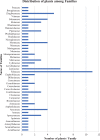Ethnobotany of Medicinal Plants Used by Rakhine Indigenous Communities in Patuakhali and Barguna District of Southern Bangladesh
- PMID: 33356558
- PMCID: PMC7780196
- DOI: 10.1177/2515690X20971586
Ethnobotany of Medicinal Plants Used by Rakhine Indigenous Communities in Patuakhali and Barguna District of Southern Bangladesh
Abstract
An extensive study has been made to identify, document, and investigate the ethnomedicinal plants used by Rakhine ethnic minorities in Patuakhali and Barguna District of southern Bangladesh for the term of April 2018 to June 2019. In this article, we have focused on the Rakhine population trends, management concerns, and some actions for conserving the Rakhine population diversity in the study area. In this study, we have identified the locations where Rakhine population lives in Patuakhali and Barguna districts. A total of 86 plant species belonging to 71 genera and 43 families were reported to be used for treating more than 57 various physical ailments under 14 illness categories from the study area. For each of the species, the botanic name, common name, Rakhine name, family, habit, parts used and traditional medicinal uses of the plant species have been presented. The maximum numbers of ethnomedicinal plant species were utilized to treat gastrointestinal complaints (43) taken after by the treatment of dermatological issues (36). The highly cited (75.60%) plant species were found to be Ananas comosus and Aegle marmelos used for gastro-intestinal (Stomach pain, indigestion, and dysentery) digestive disorders and subsequently followed by Colocasia esculenta (70.73%) used for cut, bleeding and wound healing. The results of this study have shown that Rakhine indigenous communities still depend on conventional plant-based medication to remedy various diseases and therapeutic purposes in the study area. Our findings have also shown that despite there have adequate phytodiversity in the natural habitat of the study area but the number of Rakhine population has been declining significantly day-by-day. As an ultimate result, we have lost the plant-based traditional medicinal knowledge of Rakhine indigenous communities in Bangladesh. As a rich source of traditional knowledge and cultural diversity, it calls for urgent initiatives to conserve the cultural heritage of the Rakhine community as well as the diversity of Rakhine ethnic group.
Keywords: Rakhine indigenous community; conservation; ethnobotany; medicinal plant; traditional knowledge; traditional medicine.
Conflict of interest statement
Figures







Similar articles
-
Contributions to the phytotherapies of digestive disorders: Traditional knowledge and cultural drivers of Manoor Valley, Northern Pakistan.J Ethnopharmacol. 2016 Nov 4;192:30-52. doi: 10.1016/j.jep.2016.06.049. Epub 2016 Jun 25. J Ethnopharmacol. 2016. PMID: 27353866
-
Ethnobotanical study of plants used by the Munda ethnic group living around the Sundarbans, the world's largest mangrove forest in southwestern Bangladesh.J Ethnopharmacol. 2022 Mar 1;285:114853. doi: 10.1016/j.jep.2021.114853. Epub 2021 Nov 23. J Ethnopharmacol. 2022. PMID: 34822959
-
Cultural significance of medicinal plants in healing human ailments among Guji semi-pastoralist people, Suro Barguda District, Ethiopia.J Ethnobiol Ethnomed. 2021 Oct 18;17(1):61. doi: 10.1186/s13002-021-00487-4. J Ethnobiol Ethnomed. 2021. PMID: 34663365 Free PMC article.
-
An overview on ethnobotanico-pharmacological studies carried out in Morocco, from 1991 to 2015: Systematic review (part 1).J Ethnopharmacol. 2021 Mar 1;267:113200. doi: 10.1016/j.jep.2020.113200. Epub 2020 Aug 1. J Ethnopharmacol. 2021. PMID: 32750461
-
A cross-cultural analysis of Jammu, Kashmir and Ladakh (India) medicinal plant use.J Ethnopharmacol. 2014 Sep 11;155(2):925-86. doi: 10.1016/j.jep.2014.06.029. Epub 2014 Jun 19. J Ethnopharmacol. 2014. PMID: 24952280 Review.
Cited by
-
Previously published ethno-pharmacological reports reveal the potentiality of plants and plant-derived products used as traditional home remedies by Bangladeshi COVID-19 patients to combat SARS-CoV-2.Saudi J Biol Sci. 2021 Nov;28(11):6653-6673. doi: 10.1016/j.sjbs.2021.07.036. Epub 2021 Jul 17. Saudi J Biol Sci. 2021. PMID: 34305428 Free PMC article.
-
Carica papaya Leaf Juice for Dengue: A Scoping Review.Nutrients. 2022 Apr 11;14(8):1584. doi: 10.3390/nu14081584. Nutrients. 2022. PMID: 35458146 Free PMC article.
-
Two rare flavonoid glycosides from Litsea glutinosa (Lour.) C. B. Rob.: experimental and computational approaches endorse antidiabetic potentiality.BMC Complement Med Ther. 2024 Feb 1;24(1):69. doi: 10.1186/s12906-024-04337-0. BMC Complement Med Ther. 2024. PMID: 38302935 Free PMC article.
-
Evidence for Natural Products as Alternative Wound-Healing Therapies.Biomolecules. 2023 Feb 27;13(3):444. doi: 10.3390/biom13030444. Biomolecules. 2023. PMID: 36979379 Free PMC article. Review.
References
-
- Lee S, Xiao C, Pei S. Ethnobotanical survey of medicinal plants at periodic markets of Honghe Prefecture in Yunnan Province, SW China. J Ethnopharmacol. 2008;117(2):362–377. - PubMed
-
- World Health Organization. General Guidelines for Methodologies on Research and Evaluation of Traditional Medicine World Health Organization. 2000.
-
- Banglapedia. National Encyclopedia of Bangladesh. Asiatic Society of Bangladesh. 2015. Accessed November 2, 2020 http://en.banglapedia.org/index.php?title=Flora
-
- Halim MA, Chowdhury MS, Wadud AI, Uddin MS, Sarker SK, Uddin MB. The use of plants in traditional health care practice of the Shaiji community in Southwestern Bangladesh. J Trop For Sci. 2007;19(3):168–175.
-
- Barman DC, Neo MS. Human Rights Report 2013 on Indigenous Peoples in Bangladesh. Kapaeeng Foundation; 2014.
Publication types
MeSH terms
Substances
LinkOut - more resources
Full Text Sources
Medical
Research Materials
Miscellaneous

